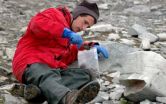(Press-News.org) GAINESVILLE, Fla. --- Butterflies are among the most vibrant insects, with colorations sometimes designed to deflect predators. New University of Florida research shows some of these defenses may be driven by enemies one-tenth their size.
Since the time of Darwin 150 years ago, researchers have believed large predators like birds mainly influenced the evolution of coloration in butterflies. In the first behavioral study to directly test the defense mechanism of hairstreak butterflies, UF lepidopterist Andrei Sourakov found that the appearance of a false head – a wing pattern found on hundreds of hairstreak butterflies worldwide – was 100 percent effective against attacks from a jumping spider. The research published online March 8 in the Journal of Natural History shows small arthropods, rather than large vertebrate predators, may influence butterfly evolution.
"Everything we observe out there has been blamed on birds: aposematic coloration, mimicry and various defensive patterns like eyespots," said study author Andrei Sourakov, a collection coordinator at the Florida Museum of Natural History's McGuire Center for Lepidoptera and Biodiversity on the UF campus. "It's a big step in general and a big leap of faith to realize that a creature as tiny as a jumping spider, whose brain and life span are really small compared to birds, can actually be partially responsible for the great diversity of patterns that evolved out there among Lepidoptera and other insects."
Sourakov's behavioral experiments at the McGuire Center showed the Red-banded Hairstreak butterfly, Calycopis cecrops, whose spots and tail imitate a false head, successfully escaped all 16 attacks from the jumping spider, Phidippus pulcherrimus. When 11 other butterfly and moth species from seven different families were exposed to the jumping spider, they were unable to escape attack in every case. Sourakov videotaped the experiments and analyzed the results in slow motion.
"From the video, you can see the spider is always very precise," Sourakov said. "In one video, the spider sees a moth that looks like a leaf and it walks very carefully around to the head and then jumps at the head region. The spider has an innate or acquired ability to distinguish the head region very well and it always attacks there to deliver its venom to the vital center to instantly paralyze the prey. Most importantly, the spider is very small, so sometimes its prey is 10 times larger."
The species of hairstreak butterfly and jumping spider used in the experiment are both common in the southeastern U.S., with similar relatives spread worldwide. In nature, the spider and hairstreak come into contact when the butterfly lands on leaves or flowers to rest and feed. Female red-banded hairstreak butterflies lay their eggs in leaf litters, which are often crawling with spiders.
David Wagner, a professor of ecology and evolutionary biology at the University of Connecticut who was not involved with the study, said the research shows scientists need to rethink what drives adaptive coloration patterns because the results suggest that "birds are only part of the story."
"I'm just so impressed with Andrei's experimental protocol and the fact that the jumping spider could not catch the hairstreak butterflies," Wagner said. "His empirical study will do much to cause us to rethink the vision and the visual acuity that certain invertebrate predators have when hunting their prey and how this has really molded how some organisms not only look like, but perhaps how they act, as well."
(EDITORS: STORY MAY END HERE.)
Unlike other butterflies, hairstreaks constantly move the hind wings that carry the false head pattern, a behavior that seems to increase in the presence of the spider, as if the butterfly is attracting attention to itself, Sourakov said. In museum collections, hairstreak specimens are frequently found with the false-head portion of the wings missing. During the experiments, the spider always attacked the butterfly's false head, thereby avoiding its vital organs.
"The false head hypothesis in hairstreaks has been in circulation for a long time because people always speculated that their tails move around in order to fake out the predators, but there was little experimental evidence," Sourakov said.
Sourakov said he hopes the study encourages behavioral ecologists to further test the idea that evolution in butterflies and moths may be driven by small invertebrate predators.
"This clearly shows it's possible that many spectacular patterns that we find in smaller insects may be due to spider pressure rather than bird pressure," Sourakov said. "The butterfly escapes from the spider – it's a fairytale story."
###
END
A century old mystery as to why, for some animals, it's the father rather than the mother that takes care of their young has been cracked by scientists at the University of Sheffield and University of Bath.
Researchers from the University, in collaboration with the University of Bath and Veszprém (Hungary) found that role reversal was caused by an imbalance in the numbers of males relative to females.
The findings have been published in the journal Nature Communications.
Darwin noted in 1871 that in most animals, it is the females that spend most time looking after ...
An additional 1,000 patients could undergo kidney transplants in the United States annually if hospitals performed more transplants using paired kidney exchanges, new Johns Hopkins research suggests.
Also known as kidney chains, paired kidney exchanges, which allow incompatible donors to give a kidney on a loved one's behalf and ensure that loved one gets a compatible kidney from a third party — usually a stranger — in return, have become much more common since 1999 when The Johns Hopkins Hospital pioneered the practice. But the dramatic growth in the use of these exchanges ...
Researchers have determined a way to predict and protect against new strains of the flu virus, in the hope of improving immunity against the disease.
Influenza is a rapidly spreading acute respiratory disease. Worldwide, annual seasonal epidemics of the flu result in 3-5 million cases of severe illness, and up to 500 000 deaths. A newly emerged virus can spread across 74 countries in 2 months.
The study led by the University of Melbourne with Monash University and international colleagues has found how to predict and potentially stop the mutating cells of the influenza ...
Although they live in similarly extreme ecosystems at opposite ends of the world, Antarctic insects appear to employ entirely different methods at the genetic level to cope with extremely dry conditions than their counterparts that live north of the Arctic Circle, according to National Science Foundation- (NSF) funded researchers.
Writing in the Proceedings of the National Academy of Sciences, the researchers concluded, "Polar arthropods have developed distinct... mechanisms to cope with similar desiccating conditions."
The researchers noted that aside from the significance ...
New Rochelle, NY, March 12, 2013—The foodborne bacteria Listeria monocytogenes sickens about 2,500 people in the U.S. each year and many more worldwide, killing about 25-30% of those infected. Listeriosis is caused by eating food contaminated with L. monocytogenes, and current methods for detecting the bacteria are costly and time consuming. An innovative nanotechnology-based method for developing an inexpensive biosensor to detect the pathogen in food is described in Industrial Biotechnology, a peer-reviewed journal from Mary Ann Liebert Inc., publishers (http://www.liebertpub.com). ...
ANN ARBOR, Mich. — The skin cancer growing on Carolyn Bohlmann's nose was not a very aggressive variety. But it was deep and located right on her nostril. The tricky part was not so much removing it – MOHS surgery, the procedure Bohlmann had, is a fairly common outpatient procedure.
The tricky part would be reconstructing her nostril so that it didn't lift up or droop down. It's an important cosmetic issue, but it's also critical for breathing.
Bohlmann opted for a new reconstruction technique her surgeon, Jeffrey Moyer, M.D., was offering at the University of Michigan ...
ANN ARBOR— Cryptic comments seem to have an ambiguous, obscure or hidden meaning. In biology, cryptic species are outwardly indistinguishable groups whose differences are hidden inside their genes.
Two University of Michigan marine biologists have identified three cryptic species of tiny clams, long believed to be members of the same species, which have been hiding in plain view along the rocky shores of southern Australia for millions of years.
The unusual convergence of a climate-cooling event and the peculiarities of local geography caused the three cryptic species ...
HeLa cells are the world's most commonly used human cell lines, and have served as a standard for understanding many fundamental biological processes. In a study published today in G3: Genes, Genomes and Genetics online, scientists at the European Molecular Biology Laboratory in Heidelberg, announce they have successfully sequenced the genome of a HeLa cell line. It provides a high-resolution genomic reference that reveals the striking differences between the HeLa genome and that of normal human cells. The study could improve the way HeLa cells are used to model human biology.
The ...
Once Andrei Tokmakoff gets his new laser laboratory operational later this year, he will use the world's shortest infrared light pulses to pluck molecular bonds like a stringed musical instrument.
Tokmakoff, the Henry G. Gale Distinguished Service Professor of Chemistry, arrived at the University of Chicago in January to tackle new problems in biology with the aid of ultrafast vibrational spectroscopy methods that he has developed.
"He does very sophisticated spectroscopy, in particular vibrational spectroscopy," said Richard Jordan, professor and chairman of chemistry. ...
Researchers from Sahlgrenska Academy, University of Gothenburg, Sweden, have found that a commonly used drug to treat anemia in heart failure patients does not improve patients' health, nor does it reduce their risk of death from heart failure. Results of the international study were presented at the American College of Cardiology's annual meeting in San Francisco on March 10 and published simultaneously online by The New England Journal of Medicine.
Initiated in 2006, the RED-HF (Reduction of Events With Darbepoetin Alfa in Heart Failure) trial involved 2,278 anemic ...



